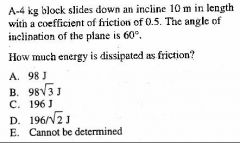![]()
![]()
![]()
Use LEFT and RIGHT arrow keys to navigate between flashcards;
Use UP and DOWN arrow keys to flip the card;
H to show hint;
A reads text to speech;
5 Cards in this Set
- Front
- Back
|
If two objects move together after impact, is the collision elastic or inelastic?
|
inelastic.
|
|
|
What occurs during an inelastic collision?
|
kinetic energy is lost due to heat, sound, deformation, etc. ==>
- cannot use equation for conservation of kinetic energy. - can use the equation for conservation of momentum. |
|
|
If one object is moving straight north and another object hits it at an angle, what will be the speed and its direction of the combined objects (inelastic collisions)?
|
break down x and y components and use conservation of momentum (cannot use conservation of KE since inelastic).
- Note: The final angle should be less than the angle that the object hit at. |
|
|
- Direction of before will be the same as direction after b/c momentum is conserved!
- The initial momentum of the system is simply the momentum of the 1.0-kg object, since the other object is at rest. The momentum is 1.0kg x 5m/s = 5kg m/s pointing to the south. Since the momentum is conserved, this must also be the final momentum of the system after the collision. |

Ball is traveling south and hits another ball at rest. What is the momentum after the collision.
|
|
|
delta(E)=Work=Fd
BE AWARE OF THAT THE QUESTION IS ASKING YOU ONLY FOR THE ENERGY DONE BY FRICTION. SO ONLY FIND THE FRICTIONAL FORCE AND SOLVE FOR WORK. |

how much energy is dissipated as friction.
|

